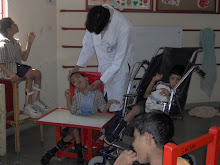| Michael Nagle for The New York Times |
My first experience with communication charts was while working as a volunteer at a school for special needs children in Chennai, India. Most of the children in the school who could not communicate verbally were given a cardboard sheet with different pictures stuck on them, some even had a QWERTY keyboard stenciled on the board. Most of the children could communicate with a stranger (i.e. me) with a series of simple easy to understand symbols. A hand wave to say hi, signs for food, water, stop. The older children even knew how to spell out words. The list was limited to what could be fit on a 12 inch x 24inch cardboard sheet and teaching the children required endless patience on behalf of the special educators and parents alike, but they worked.
How does a Communication Chart Work?
Communication Charts are a part of a technique called Alternate and Augmentative Communication or AAC. AAC systems can include:
- object choice boards
- picture communication boards (examples provided)
- chat books
- request cards
- social stories
- timetables/daily schedules
- computerised and voice output AAC systems
- gestures and signing
Is there a standardized chart?
Yes and no. While the basic setup of charts remains the same world over, each center tends to simplify and add or delete items to suit local and cultural needs
A typical chart would be similar to this set that DCSN found. Developed by the children's hospital at Westmead in Australia, these charts are simple and easy to understand, and would easily overcome many cultural barriers. The biggest drawback of the traditional chart however is that it is limited to the space available on the board. This requires the fabrication of several charts causing them to be difficult to carry.
Computer Based Charts
Ever since the advent of computers efforts were made to computerize communication charts. The computer facilitated the storage of multiple images and with a click of a mouse the child could indicate what she/he wanted. The communication charts were simple, computers, though were still a luxury, laptops were something only software engineers and CEOs possessed and the cellphone was meant for the sole purpose of talking. While computer based charts found their way into many special schools the inability to carry them around meant that these charts could not be carried around. many children also did not possess the dexterity to move a mouse around.
Enter the touch screen cellphone
The touch screen cell phone overcomes all the above mentioned limitations. Parents can condense charts onto their phones. It also makes sense for the special care dentist to possess a simple communication chart on her phone. The charts need no real training to master, and can serve as a useful tool in establishing a reliable means of communication.
For more information on communication charts access the following link
http://www.chw.edu.au/parents/kidshealth/disability/communication.htm






